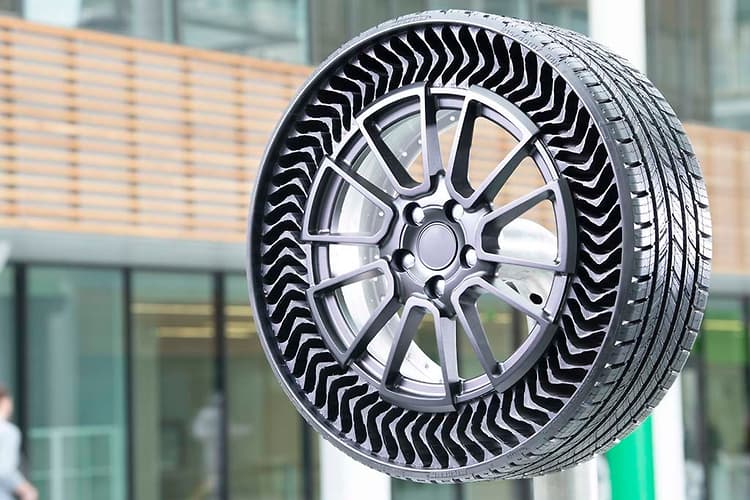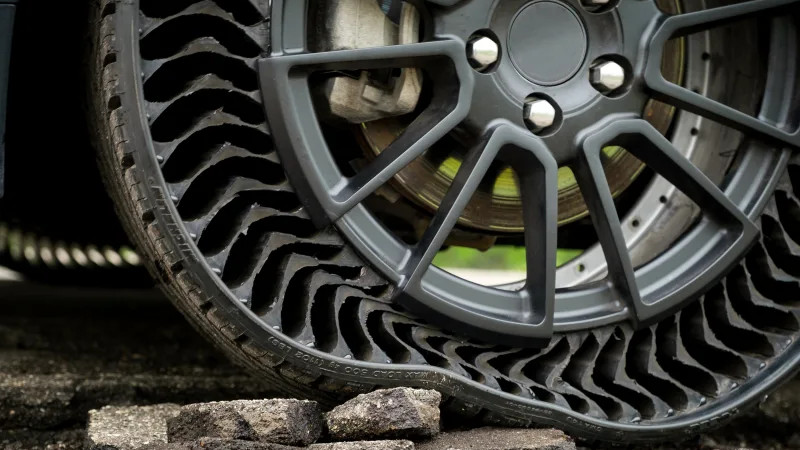The average motorist has a lot to keep track of these days. Whether its how much fuel is left in the tank, how much charge is left in the battery, or whether or not the cop behind noticed them checking Twitter, there’s a lot on a driver’s mind. One thing they’re not thinking about is tires, theirs or anyone else’s for that matter. It a testament to the state of tire technology, they just work and for quite a long time before replacements are needed.
There hasn’t been a major shift in the underlying technology for about fifty years. But the times, they are a changing — and new tire technology is claimed to be just around the corner. Several companies are questioning whether the pneumatic tire is the be-all and end all, and futuristic looking prototypes have been spotted at trade shows the world over.
It’s Been A Long Innings For The Pneumatic Tire

Pneumatic tires first came into existence in the 19th century, and were first fitted to an automobile by Andre Michelin in 1895, with mixed results. Over the next few decades, the technology rapidly matured, with advancements coming thick and fast.
Fast forward over 100 years later, and pneumatic tires continue to rule the roost. The last major sweeping technological change was the switch from bias-ply to radial construction, with the vast majority of automakers abandoning the former by the 1970s. In the intervening time, there have been steady, continuous improvements to tire compounds and tread designs, but little that the average consumer would notice on a day to day basis.
The only remaining service task for the pneumatic tire is ensuring it has air in. Failing to do so causes premature wear on the tire and can lead to blowouts. To avoid complication of neglectful car owners, several manufacturers have been developing designs for tires that don’t use air at all.
The Newcomer Is a Return to Spokes
The vast majority of airless designs follow a similar theme. An outer ring is fitted with a rubber tread, which connects to the hub with a series of polymer spokes. The weight of the vehicle hangs from the top of the ring, placing the spokes in tension. Bridgestone and Sumitomo have both displayed prototype designs, but it’s Michelin that have been making the biggest public push for the technology.
Michelin recently announced its new Uptis design which has a chevron shape to the spokes. The company and plans to launch the product in partnership with GM as soon as 2024. It’s been a long road getting to this point, with Michelin first going public with their Tweel prototype way back in 2005. Initial prototypes suffered with noise and vibrations, but were promising enough to get the development ball rolling.

There have been other obscure players, too. Resilient Technologies debuted an airless setup for military applications back at SEMA in 2009, though little has been heard since. Going back even farther, however, is the Martin Elastic tire, developed way back in the 1930s and tested on Jeeps of the era.
Thus far, none of these concepts have made it to the automotive market. To understand why, we should first look at why anyone would want to develop airless tires in the first place.
A Concept That Shows Promise
The benefits of the airless tire have been touted far and wide by manufacturers. There are a number of bountiful fruits that the technology has to offer.
The most obvious is that punctures, flats, and blowouts will become a thing of the past. Not only does this have the direct benefit of reducing inconvenience, but it also means that luggage space is freed up because it will no longer be necessary to carry a spare tire, and a boost to mileage as that dead weight is eliminated. Tire pressure monitoring systems will also no longer be a necessity. Huge numbers of tires are thrown away each year due to this very reason, well before the tread or other components are worn out. Getting rid of this problem promises to improve tire longevity significantly.
One of the main benefits is lateral stability. In standard radial tires, it’s not possible to improve lateral stiffness without affecting other properties of the tire. Stiffening the tire in this way can lead to the tire offering a harsh ride, particularly over bumpy surfaces. However, due to the construction of the airless designs, the tire can be made to be forgiving in the vertical axis, while being stiff from side-to-side. This has the benefit of making handling far more sharp, which is of particular interest for sporting and high-performance applications.
The contact patch of an airless tire is another point of interest. Unlike air-filled tires, which by necessity bulge out at the sides with air pressure, the contact patch of an airless tire can be far more consistent and flat. By having no air, it no longer rests on the driver’s shoulders to ensure their tires are sitting at the correct pressure to maintain the proper contact patch.
Another boon of the technology is wear. Despite tire pressure monitors now being widespread, and manufacturers trying to educate drivers about proper tire rotation practices, very few consumers take good care of their tires. Running under or overinflated can prematurely wear a set of tires, but with airless design, this isn’t an issue. Additionally, manufacturers claim that it should be possible to easily and safely replace the tread on such designs, with little to no degredation in performance. This would have huge sustainability ramifications; current estimates are that 1.5 billion tires are discarded each year. Any improvements in the recyclability of tire components could have a major impact.
There are more fantastical possibilities, too. Having an airless design brings the possibility of perforating the tire to create channels for water to flow away. By no longer requiring the water to be pushed out from under the tire. Developments in this area could greatly reduce the chance of aquaplaning when driving through standing water. Since aquaplaning can lead to total loss of control of a vehicle, any improvements in this space have the potential to save money and lives.
Of course, until the rubber quite literally hits the road, this is all heresay. While Michelin have been shipping Tweel products for several years now, they’re limited to low-speed rugged applications, like skid-steer loaders and ride-on lawnmowers. Getting airless tires ready for the highway is going to take some time yet.
What’s The Big Hold Up?
Despite the concept first hitting the news back in 2005, and successful test runs at Hot Rod Power Tour in 2013, we still haven’t seen these products hitting passenger cars en masse just yet. There are several engineering problems to be solved before airless designs are ready for the mainstream.
One of the major issues that is readily apparent at a glance is the potential for debris to become lodged in the spokes. In order to function properly, the spokes must be able to flex freely, Hard objects could quickly damage the spokes if caught up inside, sand, mud, or snow could clog them, causing the wheels to become unbalanced.

Speed has been a particular sticking point for the Michelin designs, with most of their current Tweel products being limited to low-speed operation. Their upcoming Uptis designs are diverging significantly from their earlier Tweel prototypes in an attempt to better meet the needs of passenger vehicles, which are heavier and travel much faster than UTVs and lawnmowers. Any viable design will have to be able to withstand hours of high-speed highway driving without overheating, delaminating, or otherwise failing — and tire companies have had problems getting it right even with conventional designs.
While an airless tire, by definition, can’t puncture or run flat, it has its own unique set of problems. Spokes can be cut, torn, ripped or otherwise damaged, reducing the life of the tire. Currently, very little data exists on these failures due to the prototype nature of the technology. There’s also the possibility of delamination of the tread and outer ring, and other failures related to the unique construction of the tires. It’s important to solve these problems before the tires are put into service with the general public. To do this requires a great amount of testing, which necessarily takes a great amount of time.
Consumer opinion will likely take some time to come around to the idea, Pneumatic tires have been de rigeur for over a century, and airless designs are a radical departure from what has come before. It will likely take significant effort on the part of manufacturers to help customers grow accustomed to the quirks of the new technology. There will be inherent, unforseen limitations, and the designs may not be suitable to fit to existing vehicles.
It’s unlikely that these issues are unsolvable. However, to overcome these problems, and to take a new design to the point where it is ready to face the wild outside world takes a huge amount of engineering effort. Michelin appears to be leading the field, and have been slowly grinding away on the project since the late 1990s.
While nobody can say if these airless tires will ever take off, I want to see an increasing pace of testing and development than we have observed over the past decade. The technology has matured further with each public prototype that has been revealed. It’s clear that there are significant gains to be had, justifying the continued investment into the concept. I eager to know what comes next, and can’t wait to try out the latest tires on the road.



















It’s awesome tires ….how can I purchase for my car plz.?
to avoid debris getting in between the spokes, cover the tire like ordinary tires but with tiny hole so air can go in and out while still limiting the bigger debris from lodging in spokes